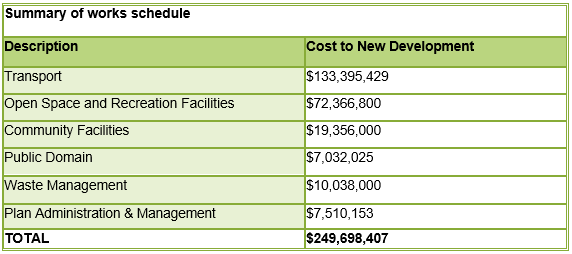Consultation has concluded
Consultation for this project has now closed and engagement reportavailable for viewing.
Council is currently reviewing its Local Infrastructure Contributions Framework. In 2024, a draft Local Infrastructure Contributions Plan for the entire Local Government Area (LGA) was prepared. This marked the first comprehensive review of Council’s Local Infrastructure Contributions Framework in over 30 years, highlighting the importance of this process.
The draft plan was publicly exhibited from October 14 to November 22, 2024, during which a substantial amount of feedback was received from the community and industry stakeholders.
In response to this feedback, revisions have been made to the draft plan to enhance its clarity, readability, and overall interpretability. Some information has been moved to appendices to create a more organised and straightforward presentation, along with expanded details on key topics such as apportionment, nexus considerations, and the mechanisms for administering the plan. This aims to provide greater clarity for stakeholders.
Additionally, the works schedule has been updated to include new items as appropriate, aligned with Council strategies to support anticipated growth. Enhanced details, including specific cost estimates where available, have been added to aid in financial planning and promote transparency. Some project items have been reclassified based on stakeholder feedback, and more detailed descriptions have been created to improve community understanding and assist Council staff in effective implementation.
Due to the significant changes made to the draft plan, Council has decided to re-exhibit it and seek further input from the community and industry.
The draft plan aims to levy approximately $250 million in contributions to deliver about $660 million worth of infrastructure and services.
The draft contribution rates vary across different areas. The summary indicates that most catchments will see a decrease in charges under the draft Plan. However, increases are expected in Sancrox, Lake Cathie/Bonny Hills, and the Camden Haven. This situation is primarily due to the higher costs associated with servicing these specific areas.
The standardisation of catchments reduces administrative complexity and variation in charges, leading to more transparent data. Consequently, the comparison table does not reflect the same area data but instead provides a general indication of changes across the aggregated areas. While standardising catchments limits variability in charges for both existing and new areas, it also minimises the administrative burden for Council by adopting a categorical approach rather than managing multiple bespoke areas. This results in a much more efficient and effective plan.
You can provide feedback on the plan by:
- Completing the online survey
- Emailing your feedback to: council@pmhc.nsw.gov.au
- Posting to:
Chief Executive Officer
Port Macquarie-Hastings Council
PO Box 84
Port Macquarie NSW 2444
The survey closes 5pm, Monday June 2 2025.
Survey
CLOSED: This survey has concluded.
Survey
This survey closes 5pm, Monday June 2 2025.
Note: Information collected via submissions and petitions is public information, this information may form part of Council reports or made public in their entirety subject to the provisions of the Local Government Act 1993 or the Government Information (Public Access) Act 2009 (GIPA Act). You may request, in writing, that Council suppress the personal information in your submission from public release, if you consider that the personal safety of any person would be affected if the information was not suppressed Any such request will be dealt with in accordance with the GIPA Act and the Privacy and Personal Information Protection Act 1998
Information Session Registration
CLOSED: This survey has concluded.
Information Session – Development Contributions Update
Date: Tuesday, 20th May 2025
Time: 5:00 PM – 6:00 PM
Location: Zoom
You are invited to attend an information session to discuss the recent changes made to the Development Contributions, incorporating feedback from the previous exhibition period.
The session will cover:
- An overview of the process to date
- Key updates based on community input
- A Q&A segment







